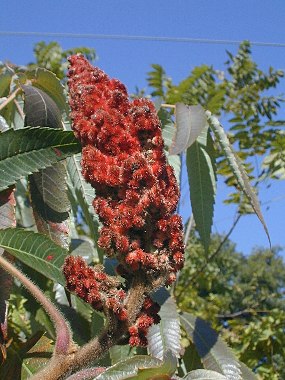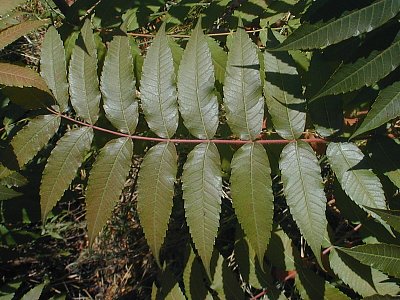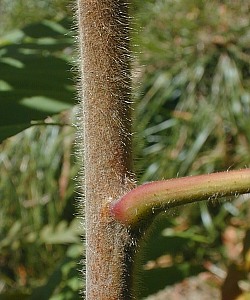Description: This woody plant is a shrub or small tree up to 30' tall that branches occasionally. The upper stems (or branchlets) are covered with dense brown hairs, while the lower stems (trunk or branches) are brown, hairless, and woody. The short trunk is up to 9" across in diameter. The alternate compound leaves are up to 2' long (if not longer); they are oddly pinnate, consisting of 9-31 leaflets. The petioles and central stalks of these compound leaves have scattered brown hairs; the central stalks are often tinted red. The leaflets are up to 5" long and 1" across; they are oblong-lanceolate and serrated along the margins. The upper surface of each leaf is shiny and dark green (becoming red or burgundy during the fall), while the lower surface is pale white. Each leaflet is nearly sessile at the base, and tapers gradually to an elongated tip.

Some of the upper stems terminate in individual panicles of greenish yellow flowers up to 1' long and ½' across. Each flower is about ¼" across, consisting of 5 spreading petals, a calyx with 5 lobes, 5 stamens, and a central pistil. Usually, the flowers of Staghorn Sumac are perfect (they have both stamens & pistils), although a few plants produce unisexual flowers only (either all staminate flowers or all pistillate flowers). The blooming period occurs during early to mid-summer and lasts about 2-3 weeks. Each flower is replaced by a globoid drupe about 1/6" (4 mm.) long, which is densely covered with bright red hairs. This drupe contains a single seed with a hard coating. The drupes mature during the fall and persist through the winter; if not eaten, they eventually become dark brown. The root system is woody and can produce vegetative clones from long runners. This plant occasionally forms colonies.
Cultivation: The preference is full to partial sun, mesic to dry conditions, and a loam, clay-loam, or rocky soil. This woody plant can spread aggressively by means of underground runners, although the new clonal shoots are intolerant of regular mowing.

Range & Habitat: Staghorn Sumac occurs occasionally in the northern half of Illinois, while it is uncommon in the southern half of the state (see Distribution Map). This species is native to the northern half of Illinois, otherwise it is adventive. Habitats include open upland woodlands, woodland borders, thickets, rocky barrens with sparse woody vegetation, dry riverbanks, and areas along railroads. Like other Rhus spp. (Sumacs), this species thrives on moderate levels of disturbance. It can invade prairies or meadows, but declines in the presence of tall canopy trees. Staghorn Sumac has been grown as an ornamental shrub or small tree in residential areas, although this is fairly uncommon.
Faunal Associations: The nectar and pollen of the flowers attract various insects, including bumblebees, other long-tongued bees, Halictid bees (Halictus spp., Lasioglossum spp.), masked bees (Hylaeus spp.), Andrenid bees (Andrena spp.), ants (Camponotus spp., Formica spp.), miscellaneous beetles, and probably miscellaneous flies (Wilhelm & Rericha, 2017; Lovell, 1915). Some of the beetle visitors may gnaw on the flowers. Other insects that feed on various parts of Staghorn Sumac include the Sumac Flea Beetle (Blepharida rhois), Sumac-grass Aphid (Carolinaia rhois), Sumac Gall Aphid (Melaphis rhois), Fork-tailed Bush Katydid (Scudderia furcata), larvae of two butterflies, the Red-banded Hairstreak (Calycopis cecrops) and Spring Azure (Celastrina ladon), and larvae of two moths, the Showy Emerald (Dichorda iridaria) and Dark Marathyssa (Marathyssa inficita); see Clark et al. (2004), Pepper (1965), Wilhelm & Rericha (2017), Covell (1984/2005), Opler & Krizek (1984), and Gangwere (1961). The Insect Table provides a more complete list of insects that feed on sumac shrubs (Rhus spp.). Among vertebrate animals, the fruits of Staghorn Sumac are eaten by many kinds of birds, including the Cedar Waxwing, Evening Grosbeak, Pine Grosbeak, Red-headed Woodpecker, Black-capped Chickadee, and Ruffed Grouse (DeGraaf, 2002). The Bird Table provides a more complete list of birds that feed on the fruits of sumac shrubs. The American Moose and White-tailed Deer browse on the leaves, twigs, and occasionally the fruits of these shrubs, while the Cottontail Rabbit gnaws on their bark during the winter months (Martin et al., 1951/1961; Myers et al., 2004). In general, the ecological value of sumac shrubs to wildlife is fairly high.

Photographic Location: A gravelly area along a railroad in Urbana, Illinois.
Comments: This is the tallest sumac species in Illinois. It is less common than Rhus glabra (Smooth Sumac). Staghorn Sumac is easy to identify in the field because its young branches are covered with dense brown hairs. These hairs have the appearance of "velvet" on a deer's antlers, hence the common name. Other sumac shrubs have young branches that are less hairy or hairless (usually the latter). Like Smooth Sumac, Staghorn Sumac has central leaf stalks without wings, and both types of sumacs have leaflets that are serrated along their margins and pale white on their undersides. However, the central leaf stalks of Staghorn Sumac have scattered brown hairs and its bright red drupes are much hairier than those of Smooth Sumac. Another scientific name of Staghorn Sumac is Rhus typhina.